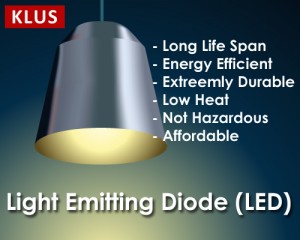 Light emitting diodes (LEDs) have become one of the biggest heroes in the world of electronics. They do many jobs and may be found in many different types of devices. Your alarm clock probably uses LEDs to form the numbers that tell the time. Your remote control may depend on an LED to work correctly. An LED may let you know if you left the oven on. Several LEDs may work together to provide LED home lighting in your living room at a fraction of the cost of an incandescent bulb.
Light emitting diodes (LEDs) have become one of the biggest heroes in the world of electronics. They do many jobs and may be found in many different types of devices. Your alarm clock probably uses LEDs to form the numbers that tell the time. Your remote control may depend on an LED to work correctly. An LED may let you know if you left the oven on. Several LEDs may work together to provide LED home lighting in your living room at a fraction of the cost of an incandescent bulb.
LED home lighting offers several advantages over standard incandescent bulbs. They do not have a filament that eventually burns out, so they offer a longer life. They plastic bulb is more durable than glass. They can provide the same amount of light in a device that is much smaller than the traditional light bulb. They are far more energy efficient that a traditional lamp.
The main advantage of LED home lighting is energy efficiency. As anyone who has ever touched an illuminate standard light bulb can testify, these devices produce a lot of heat. In order to produce light, the filament in the standard bulb is heated to the white-hot stage. The heat that is produced is wasted energy unless you are depending on the lamp as a heater. Most of the energy is wasted as heat and not used to produce visible light. In comparison, LEDs produce little heat. More of the electricity is used in the production of visible light and the energy use is cut dramatically. An LED lamp can produce almost eight times the amount of light using the same amount of energy.
In the past, LEDs cost too much to be used in the home. However, in the last decade the cost of materials for semiconductors used in their production has dropped, making the LED much more cost effective for many applications. Although the initial investment is more, their long life and energy savings make them a cost-effective option for lighting the home.
In recent years, many homeowners have made the switch to compact florescent bulbs in the home. These compact bulbs save energy and produce the same amount of light using about 25% of the energy required for an incandescent lamp. However, florescent lamps contain mercury, which is poisonous and makes it difficult to dispose of these lights. Florescent lamps produce less heat, use less energy and have a longer lifespan, but cannot match the energy savings and lifetime of an LED lamp.
LED home lighting provides energy saving and safe way for consumers to save energy in the home. While they require a larger initial investment, these lamps offer a long life and many years of energy saving lighting for the home.





